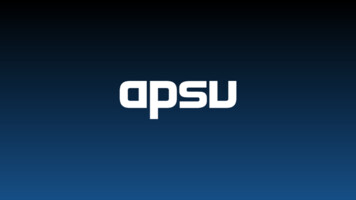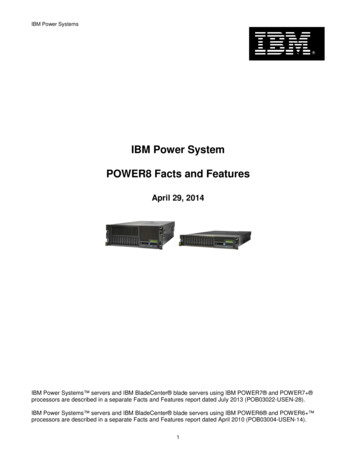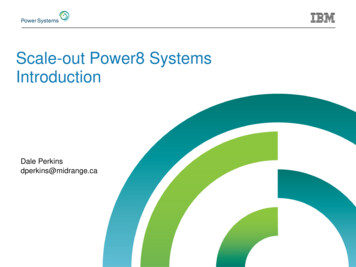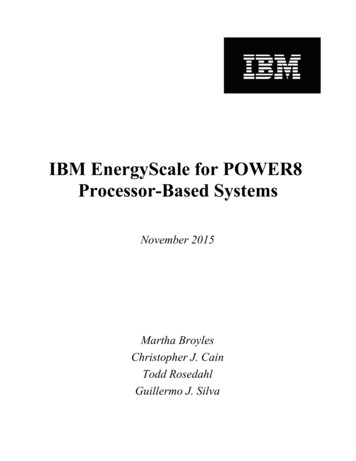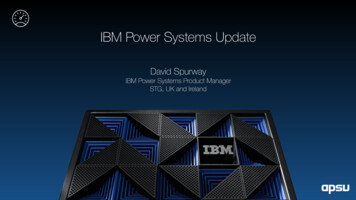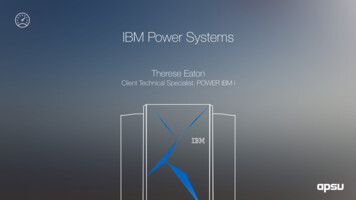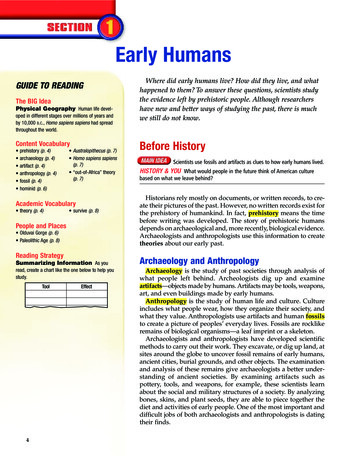
Transcription
IBM Power8David SpurwayIBM Power Systems Product Manager
IBM Power8David SpurwayIBM Power Systems Product Manager
Power Systems
Power SystemsLEGO BricksLEGO is a trademark of the LEGO Group of companies which does not sponsor, authorize or endorse this presentation
Have you seen one look like this?LEGO is a trademark of the LEGO Group of companies which does not sponsor, authorize or endorse this presentation
They even managed to do this LEGO is a trademark of the LEGO Group of companies which does not sponsor, authorize or endorse this presentation
The science behind LEGOLEGO is a trademark of the LEGO Group of companies which does not sponsor, authorize or endorse this presentation
LEGO provides the building blocksLEGO is a trademark of the LEGO Group of companies which does not sponsor, authorize or endorse this presentation
Why are Power and LEGO similar?LEGO is a trademark of the LEGO Group of companies which does not sponsor, authorize or endorse this presentation
Why are LEGO and Power Systems Similar?Heritage50 years50 yearsR&DConstant focus to remain current 1 billionMarket Leadership 1.57B revenueNumber 1 (62% Unix)Reliability 18 per million elements rejected130x more checkers in POWERprocessorsSecurity0.002 mm ToleranceMinimal Advisories & ComplianceReportingManafacturing19 Billion elements per yearCommon PlatformCostCompetition from Lego ClonesCompetition from Intel
Why are LEGO and Power Systems Similar?Heritage50 years50 yearsR&DConstant focus to remain current 1 billionMarket Leadership 1.57B revenueNumber 1 (62% Unix)Reliability 18 per million elements rejected130x more checkers in POWERprocessorsSecurity0.002 mm ToleranceMinimal Advisories & ComplianceReportingLEGO underprins the Toy Market, Power the Enterprise Server MarketManafacturingLEGO isCost19 Billion elements per yearCommon PlatformCompetition from Lego ClonesCompetition from Intela trademark of the LEGO Group of companies which does not sponsor, authorize or endorse this presentation
‘Due to the architecture and design of thecloud-based LEGO Matrix, IT is not abottleneckon growth.’!Esben Viskum, Senior Director, LEGOService CenterIBM AIX, IBM PowerHA, IBM Tivoli Storage Manager, IBM Tivoli Netcool/Webtop, IBM TivoliNetcool/OMNIbus Probe, IBM Tivoli Composite Application Manager, IBM Tivoli Monitoring,IBM Tivoli Enterprise Console, IBM Tivoli Network Manager, IBM Tivoli PerformanceAnalyzer, IBM System Storage SAN Volume Controller, IBM TotalStorage Productivity CenterIBM Power 570, IBM BladeCenter HS22 blade servers, IBM System x3650 servers, IBMSystem Storage DS4800, IBM System Storage DS8700, IBM Tape Libraryand added 2 x 9117-MMBs to their datacentres in 2011http://www- ‐01.ibm.com/common/ssi/cgi- ‐bin/ssialias?infotype PM&subtype AB&htmlfid SPC03262DKEN
‘Due to the architecture and design of thecloud-based LEGO Matrix, IT is not abottleneckon growth.’!Esben Viskum, Senior Director, LEGOService CenterIBM AIX, IBM PowerHA, IBM Tivoli Storage Manager, IBM Tivoli Netcool/Webtop, IBM TivoliNetcool/OMNIbus Probe, IBM Tivoli Composite Application Manager, IBM Tivoli Monitoring,IBM Tivoli Enterprise Console, IBM Tivoli Network Manager, IBM Tivoli PerformanceAnalyzer, IBM System Storage SAN Volume Controller, IBM TotalStorage Productivity CenterIBM Power 570, IBM BladeCenter HS22 blade servers, IBM System x3650 servers, IBMSystem Storage DS4800, IBM System Storage DS8700, IBM Tape Libraryand added 2 x 9117-MMBs to their datacentres in 2011What “Bricks” do LEGO use?http://www- ‐01.ibm.com/common/ssi/cgi- ‐bin/ssialias?infotype PM&subtype AB&htmlfid SPC03262DKEN
Power8 ProcessorTechnology 22nm SOI, eDRAM, 15 ML 650mm2CachesCores 512KB SRAM L2 / core 12 cores (SMT8) 96 MB eDRAM shared L3 8 dispatch, 10 issue, 16 exec pipe Up to 128 MB eRAM L4 (offchip) 2X internal data flows/queues Enhanced prefetching 64K data cacheMemory 32K instruction cache Up to 230 GB/s sustained bandwidthBus InterfacesAccelerators Durable open memory attachedinterface Crypto & memory expansion Transactional MemoryEnergy Management Integrated PCIe Gen3 VMM assist On-chip Power Management Micro-controller SMP Interconnect Data Move/ VM Mobility Integrated Per-core VRM CAPI (Coherent Accelerator ProcessorInterface) Critical Path Monitors
Power8 - Continued Leadership(what you expected)More CoresIndustry BestPractice!More Threads!!!12 processor cores per socket (50% more than before) that deliverbetter per core performanceWhat this meansEnjoy better scale up performance, and more throughput per scaleout server node.More CacheIndustry Leading!At 100MB, 3X the on-chip cache as POWER7 – plus 128MB of newoff-chip cache as well!What this meansMemory-intensive applications (like database) will perform better asmemory latency is reducedIndustry LeadingSMT8 – 8 dynamic threads per core, supporting SMT1, 2, 4, & 8modes dynamically across VMsWhat this meansYou choose – Deploy VM’s in the optimal SMT mode based onapplication needs.More Bandwidth!Industry Leading2.3X our prior gen to memory, and 2.4X our prior gen to I/O.!What this meansData-hungry applications (like big data & analytics) will respond twiceas fast and scale more efficiently.
Power8 - Innovating for TomorrowIndustryInnovation!Transactional Memory!!!CAPIOpen interface allows PCIe3 devices to participate in operations atmemory speed without risk.What this meansGain orders of magnitude application performance with PCI cardtechnology w/o hiring specialized skillsIndustry onPowerBorrowed from the mainframe, this technology speeds up memorywrites by reducing contention.What this meansA feature that improved OLTP database performance by 45% onSystem z is now available on Power.!PowerKVM!!!Native PCIeIntegrating PCIe Gen 3 into the processor boosts performance byeliminating logic overhead.What this meansI/O intensive data applications will run faster due to high bandwidth,low latency communications.IndustryExtendedIndustry onPowerKVM, the open-source virtualization solution, can be used to manageLinux-only systems.What this meansData centers can now standardize their clouds with a single opensource virtualization technology.
2013 Power SystemsApril 28 New Power Systems Naming TransitionPowerLinux 7R1Power 710Power 720PowerLinux 7R2Power 750Power 730Power 740PowerLinux 7R4Power 760Power 770Power 7802014 IBM Power SystemsScale-out Systems (1&2 sockets)Enterprise Systems (4 sockets)Power S812LPower S822LPower S822Power S814Power S824Announce: April 28, 2014Power 795
POWER8 thrives on the complexRunning Cognos BI reports and analytics on POWER8 with DB2 with BLU Acceleration versus Ivy Bridge with a traditional databaseSystemReportsper OWER843945X86Ivy Bridge22671850.271942784Speed rger and more complex queries have more speedupBased on IBM internal tests comparing IBM DB2 with BLU Acceleration system with a comparably tuned competitor configuration executing a materially identical 2.6TB operational analytics workload in acontrolled laboratory environment. Test measured 60 concurrent user report throughput executing identical Cognos report workloads. Report per hour (RPH) metric calculated for each category of reports astotal completed reports/hours to completion of all reports in the category. Competitor configuration: HP DL380p, 24 cores, 256GB RAM, Traditional Database, SuSE Linux 11SP3 (Database) and HP DL380p,16 cores, 384GB RAM, Cognos 10.2.1.1, SuSE Linux 11SP3 (Cognos). IBM configuration: IBM S824, 24 cores, 256GB RAM, DB2 10.5, AIX 7.1 TL2 (Database) and IBM S824, 16 cores, 384GB RAM, Cognos10.2.1.1, SuSE Linux 11SP3 (Cognos). Results may not be typical and will vary based on actual workload, configuration, applications, queries and other variables in a production environment.
DB2 10.5 on POWER8 is 2.7x Faster than Oracle DB on Exadata and 80% Lower CostDB2 AESE v10.5! Power S824 with 24 cores AIX 7.1, 64-bit!!!System Cost3 year TCA 2,094,1151,542 1,357Trade Completionsper second (TPS)per TPS FlasySystem 8402.7xFaster80%Lower cost per Tradeper secondExadata X3-2 Quarter Rack! Intel-based Processors1/4 Rack32 database cores2 Server Nodes3 Storage Nodes!561System Cost3 year TCA 3,835,481 6,837Trade Completionsper second (TPS)per TPSBased on IBM internal tests comparing the IBM system with a comparably priced, comparably tuned competitor configuration (version available as of 01/01/2013) executing a materially identical online transaction processing workload in a controlled laboratory environment. Tests measured Trade Completion throughputrates to execute identical SQL query workloads. More Trade Completions is indicated by higher Trade Completions/second. Competitor configuration: ¼ Unit (usable uncompressed capacity 9.5TB) including competitor recommended software options and features. Results may not be typical and will vary based onactual workload, configuration, applications, queries and other variables in a production environment. Users of this document should verify the applicable data for their specific environment.
NO trade-offs: 2x Throughput at Half the Cost of x86POWER8 Delivers Over TWICE the Throughput Relative to Ivy Bridge-EP at 47% Lower Cost for an Online Banking WorkloadPower S824 WebApplication!!!!!!!! !! !WASWASWASWASAIXAIXAIXAIX183,800 3.09PowerVMUser Interactionsper secondper UI per secDB2WebSphere on platformDatabase off platform2S/24 Core POWER8 (3.525 GHz)2.1xFaster47%Lower cost perUI per secOnline Banking Workload v3.6HP - ProLiant DL380p Gen8!!!!!! !85,939! !WASWASWASWASRHELRHELRHELRHEL 5.84VMware ESXi!!2S/24 Core Ivy Bridge-EP (2.7 Ghz)User Interactionsper secondper UI per secDB2WebSphere on platformDatabase off platformBoth Servers configured to achieve maximum throughputThis is an IBM internal study designed to replicate a typical IBM customer workload usage in the marketplace. The results were obtained under laboratory conditions, and not in an actual customer environment. IBM's internal workload studies are not benchmark applications, nor are they based on any benchmarkstandard. As such, customer applications, differences in the stack deployed, and other systems variations or testing conditions may produce different results and may vary based on actual configuration, applications, specific queries and other variables in a production environment. Prices, where applicable, are based onpublished US list prices for both IBM and competitor, and the cost calculation compares the cost per request for the 3yr life of the machine. 3 year total cost of acquisition comparisons are based on similar expected hardware, software, service & support offerings
SAP Sales & Distribution 2-Tier ERP 6 BenchmarksIBM Power System S824 using DB2 10.5 vs CompetitionOver 2 times better 24 core performance than nearest Intel competitive resultsUp to 2 times greater performance than previous Power generationIBM Power System S824 Performance (1)IBM Power System S824 Performance (2) (per 0000IBM Power S824 2014 International Business Machines CorporationFujitsu RX300 S8Cisco UCS C240 M3 HP ProLiant BL460cSAP SD ERP 6.0 benchmark usersSAP SD ERP 6.0 benchmark M Power S824IBM p270IBM p260
IBM Power System S824 delivers Best of Breed eBS 12.1.3 Payroll performanceOver 2 times more performance per-core than Cisco resultwith higher overall through-put on few coresIBM Power System S824 Performance (1)1,200,000IBM Power System S824 Performance (1) (per 20,000480,000240,0000Checks per hourChecks per hour960,00060,00049,34542,40240,00020,000IBM Power S824 12-core Cisco UCS C240 M3 24-coreOracle BL460c 16-core0IBM Power S824 12-core Cisco UCS C240 M3 24-coreAll results use Oracle eBS 12.1.3 Payroll Batch Extra Large Kit and are current as of 3/24/2014.For more information go to benchmark/results-166922.html 2014 International Business Machines CorporationOracle BL460c 16-core
IBM Power System S824 delivers New High-water Siebel CRM Release 8.1.1.4 performanceOver 3 times the DB performance per-core than previous resultsHighest overall users supported on fever cores!IBM Power System S824 Performance (1)IBM Power System S824 Performance (1) (per core)10,000Release 8.1.1.4 DB M Power S824 6-coreOracle SPRACT T4-2 16-coreCisco UCS B200 M3 16-coreRelease 8.1.1.4 DB users / core60,0008,3338,0006,0004,0002,5002,0006250IBM Power S824 6-core(1) All results use Siebel 8.1.1.4 PSPP Kit and are current as of 3/24/2014. For more information go to -papers/siebel-167484.html 2014 International Business Machines CorporationOracle SPRAC T4-2 16-core Cisco UCS B200 M3 16-core
Power Enterprise Pools help transform Enterprise IT for the CloudLeverage leadership IT efficiency Systems designed to run at 80-90% utilization Minimize excess capacity for peak demand, HA and contingency Deploy new workloads at lower cost & enterprise service levels!!Implement a high availability architecture Shift resources to support planned maintenance Implement Active – Active for efficient HA / DR Seamless transition to new technologyIncrease flexibility and business agility Virtualization and Cloud management built on OpenStack Elastic COD for instant, seamless response to business changes Unrivaled flexibility with Mobile COD enables rapid response tobusiness changes while minimizing risk
Power Enterprise Pools help transform Enterprise IT for the CloudEnterprise-class systems deliverleadership performance,resilience & resource sharingPowerVM virtualization and cloudsoftware simplify management &increase utilizationElastic COD and Power IFLs enablecost efficient deployment of newworkloadsEnterprise Pools with MobileCapacity provide unprecedentedflexibility and efficiencyAnnounce – 4/8 GA – 4/25 Enterprise Pools with Mobile COD for Power 770 and Power 780(Power 795 previously announced in 4Q13)!Statements of Direction Enterprise Systems with POWER8 technology will deliver moreperformance, capacity & efficiency than any prior Power system POWER8 & POWER7 servers will be able to interoperate & shareresources (processors / memory) in a single Power Enterprise Pool Clients will be able to transfer Mobile CoD resources from POWER7to POWER8 servers at no additional charge
POWER6 / POWER7/ POWER8 Partition MobilityAIX 7.1AIX 7.1AIX 7.1AIX 7.1AIX 7.1AIX 6.1AIX 6.1AIX 6.1AIX 6.1AIX 6.1AIX 5.3AIX 5.3POWER6/6 POWER7POWER8Leverage POWER6 / POWER7 Compatibility ModesLPAR Migrate between POWER6 / POWER7 / POWER8 ServersCan not move POWER8 Mode partitions to POWER6 or POWER7 systems.
Planned POWER8 support built into current AIX TLs20112012AIX 6TL7SPSPSPAIX 62013SP6TL82014SP7SP8SP9SP10SP2SP3SP4SP5TL9AIX 6AIX 7TL1SPSPSPAIX 7SP6TL2SP7SP8SP9SP10SP2SP3SP4SP5AIX 7SPx- Full I/O & POWER8 modeSPx- Full I/O support on POWER8SPx- Can live relocate to POWER8 with Virtual I/OSPx- Not supported on POWER8SP2TL3SP2
2013 Power Systems 2014 IBM Power Systems April 28 New Power Systems Naming Transition Scale-out Systems (1&2 sockets) Announce: April 28, 2014 Enterprise Systems (4 sockets) PowerLinux 7R1 Power 710 Power 720 Power 730 Power 740 PowerLinux 7R2 Power 750 PowerLinux 7R4 Power 760 Power 770 Power 780 Power 795 Power S812L
